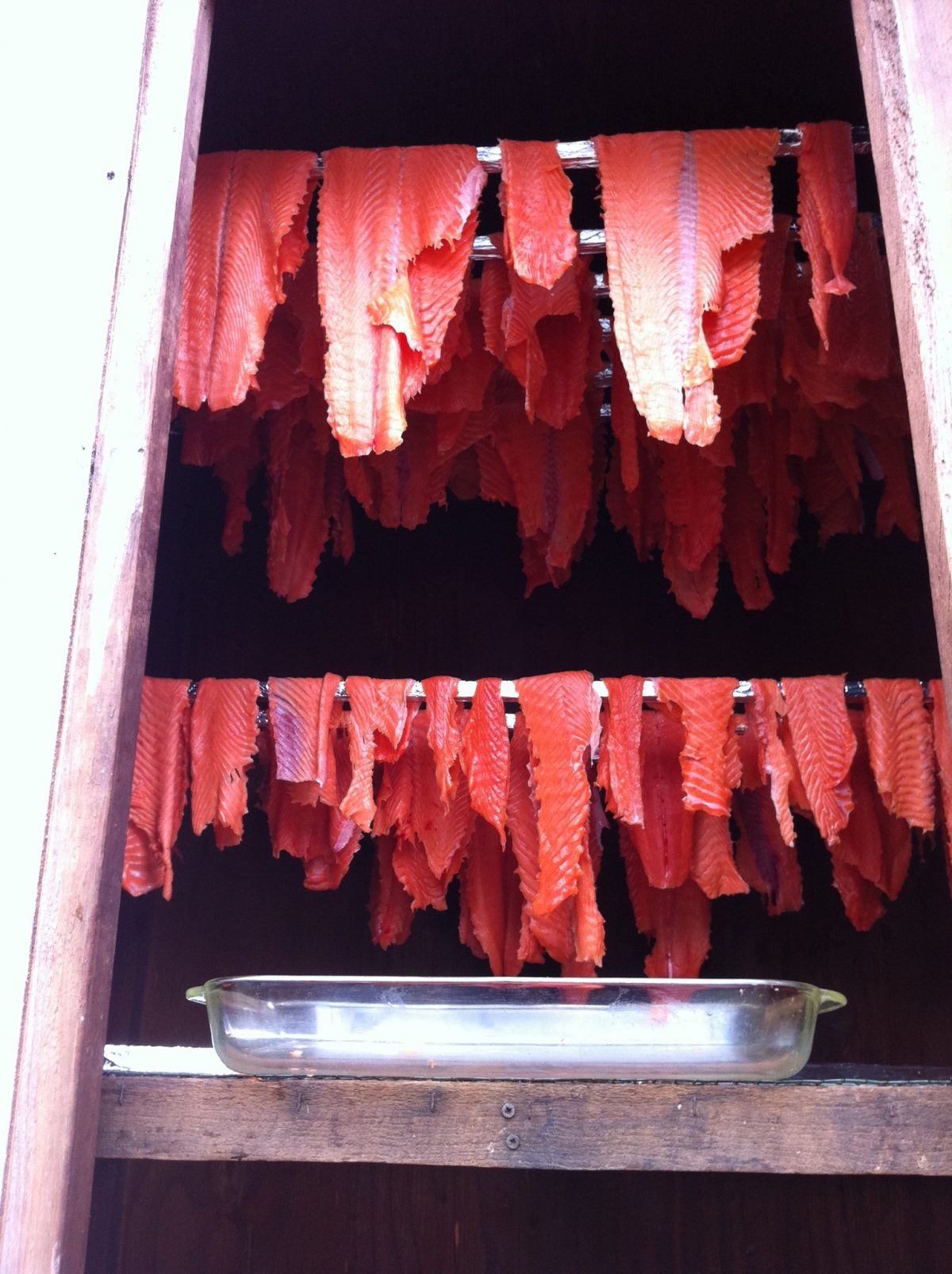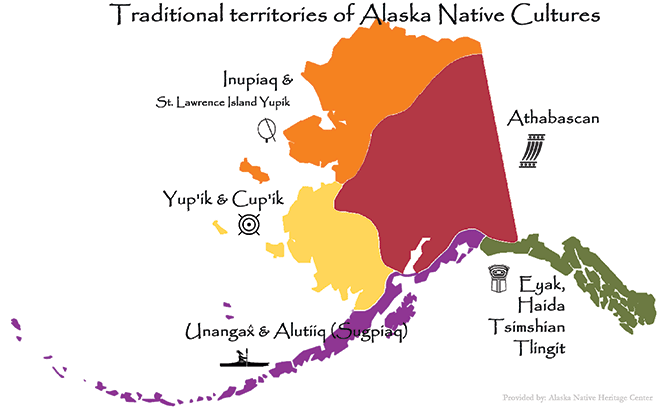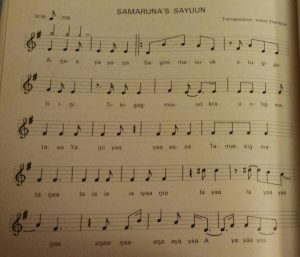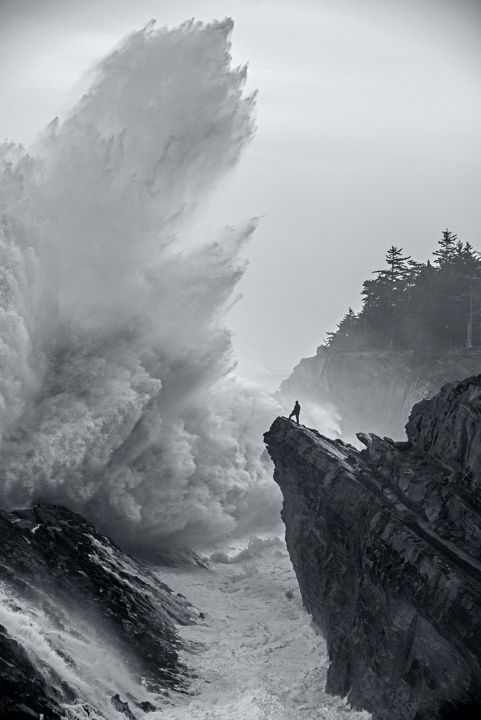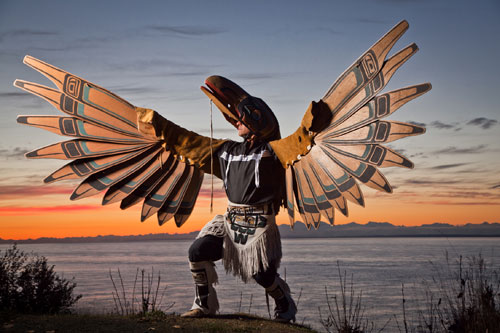Students will look at the relationship between food and health by examining the departure from traditional diets as western culture becomes more of an influence on the lives of the Northern Athabascan People. Students will learn about traditional foods, availability during various seasons, and what may be causing the departure from this diet. Students will also look at the rise of various illnesses since the introduction of western food and distributors making it readily available in remote areas. Within the context of the ibook there will be charts and photos for identification of indigenous foods, videos explaining the problems with sugar and white flour amongst first nations people, and instructions for an interactive activity where students can visually measure the amount of sugar they might be consuming on a daily basis through beverages and snacks. Students will learn how health is tied to the areas that we occupy, the importance of a whole food diet, and also about food sovereignty.
Category: Idea
The Science of Salmon
Lesson Plan Ideas…
My lesson plan idea stems from a personal interested in the science of subsistence fishing. I would love to do a whole unit on all things salmon from learning about salmon life cycles, fish management and stream surveys, fish anatomy and traditional subsistence (the science of smoked fish). I have been attempting to incorporate this into High school summer academy for a few summers now and am thrilled at the opportunity to bounce ideas off this cadre. The problem is choosing just one idea and lesson to start with!
- Intended audience? Alaska region – grade, course, etc.
Southeast Alaska Region, high school or middle school biology/ecology/life science class.
- About how much class time to do this lesson?
One class session (or all summer) with some pre-reading/watching.
- What’s the essential question? (is there one?)
“How do humans have an impact on the diversity and stability of ecosystems?”
“Are ecosystems healthy enough to provide resources and essential services?”
“Should the state of Alaska/Federal Government regulate subsistence fishing?”
- What source material would students use (include a link or example).
- Subsistence Research in Alaska: A Thirty Year Retrospective. Polly Wheeler and Tom Thornton
- Haa Atxaayí Haa Kusteeyíx Sitee, Our Food is our Tlingit Way of Life. Excerpts from Oral Interviews. Richard G. Newton and Madonna L. Moss. USDA Forest Service Alaska Region R10-MR-50 May 2009 revision
- Resiliency among the Salmon People in the Yukon Delta http://ed.ted.com/featured/Vs2D6GfT
- Alaska History and Cultural studies: http://www.akhistorycourse.org/geography/enduring-understandings-and-essential-questions
- A brief explanation of “what are the kids going to do?”
TED Ed video & essential questions to establish background knowledge and start conversations in smaller groups. Have groups share their view, compare and contrast. Or… Set up a mock civil dispute trial regarding subsistence fishing. Provide several testimonies which reflect different perspectives and opinions regarding subsistence rights, including those in fish management, fish and game, local indigenous peoples, commercial fishermen, environmentalists, etc.
Alaskan Art History Project
—This is a draft—
Audience: Alaska region school students
Grade: High school
Course: Art, Art history, Alaska history
Class time: one week
Essential question: What influences are there in the Native artwork of an Alaskan region and where did it come from? What are some of the restraints that each region had with the type of art that could be produced?
Source material (some):
- Alaska Digital Archives: http://vilda.alaska.edu/
- Anchorage Museum: https://www.anchoragemuseum.org/exhibits-events/permanent-exhibits/alaska-gallery/athabascan-indian-history/
- Alaska Native Knowledge Network: http://www.ankn.uaf.edu/curriculum/athabascan/fairbanks_school_district/ane_program/atha.artsampler.html
Explanation (brief) of “what the kids will be doing”:
During this lesson, students will explore some of the Native Alaskan Native art and what influences there are to and from neighboring regions or contact from other areas. Students in groups of three will also create an Alaskan influenced 3-D art project. This art project could focus on art and clothing or ceremonial or tools or some other expression of art.
Each group will start with a limited amount of materials and supplies that are different from other groups. Depending on the focus of the art, supplies could be beads, shells, fur, different types of leather, fabric, buttons, metal pieces, bones, antlers, hooves, feathers, paint, wood, rope, etc. Each group may need to trade supplies and ideas with neighboring groups or “regions” of the classroom. The resulting art project will show the effects of trade and influences that may have occurred with the Native Alaskan artwork of a region.
—This is a draft—
Lesson Plan – Music – Arctic Region
In this lesson, I intend to focus on the music and dance of the Inupiaq people and incorporate elements of rhythm, movement, and performance.
Age Level: appropriate for 6th grade music performance class, or 6th through 8th grade music appreciation class
Materials needed: 1 large frame drum, sheet music for traditional Inupiaq song
Duration: 1-5 class periods
Goal: Internalizing rhythm
Objectives:
1. To teach students fundamental musical concepts/skills of inner pulse and eurythmics through guided movement, kinesthetic learning, and performance
2. To teach students how to actively listen to a leader, to each other, and to the pulse of the music
3. To teach students the movements to a traditional Inupiaq dance
4. To teach students how to sing and play a traditional Inupiaq dance
5. To highlight the storytelling aspects of music
6. To show how music reveals the stories and cultural values of a people
Outcomes:
1. Students should be able to move in time with a steady pulse
2. Students should be able to demonstrate a steady pulse while playing simple rhythms on a drum
3. Students should be able to move in time with the rhythm of a traditional Inupiaq song
4. Students should be able to demonstrate the correct movements to a traditional Inupiaq dance
5. Students should be able to sing and play (on a drum or another instrument) a traditional Inupiaq song
Description:
In this lesson, students will participate in a series of 6 sequential activities, which will be either game-based or performance-based. The lesson will meld learning basic music skills, such as inner pulse and eurythmics, with learning an Inupiaq traditional song and dance with the goal of performing it.
For the game elements of this lesson, one person will play a rhythm on a drum while the rest of the class listens and moves in time with the drumbeat. For the performative elements of this lesson, students will learn the notes, rhythms, movements, and cultural context of a traditional Inupiaq song and dance.
The 6 sequential activities are as follows:
1. The class will play a movement game with a drum. The teacher will be the leader for this round of the game. The teacher plays a rhythm on the drum, and the students must take one step per beat they hear on the drum. The leader can change the rhythm, increase the tempo, or decrease the tempo at any time. The students must stay with the drumbeat at all times.
2. The class will play a different version of the movement game with the drum. This time, each student will take a turn being the leader and playing the drum. On his or her turn, each student plays a rhythm on the drum, and the rest of the class must take one step per beat they hear on the drum. The leader can change the rhythm, increase the tempo, or decrease the tempo at any time. The rest of the class must stay with the drumbeat at all times.
3. The class will play a third version of the movement game with the drum, this time using the percussion rhythm of an Inupiaq song as the basis of the activity. The teacher will be the leader again for this round of the game. The teacher plays the rhythm of the percussion part on the drum, and the students must take one step per beat that they hear. The students’ goal is to physically internalize the rhythm of the Inupiaq song.
4. The class will play a fourth version of the movement game with the drum. The teacher will be the leader. In this round, the teacher will play the melodic rhythm of the Inupiaq song on the drum. The students must take one step per beat that they hear. This will help the students to physically internalize the rhythm of the melody part.
5. The students will learn the body movements of the Inupiaq dance, which goes with the Inupiaq song to which they are being introduced.
6. The students will learn to sing, play, and dance the Inupiaq song introduced earlier in the lesson. They will apply what they learned about eurythmics and inner pulse in the earlier movement/rhythm games to the song.
Spirit Lessons
Sugpiaq/Alutiiq spirituality centers around the concept that all things possess a human like being called a sua (it’s person). People followed rituals and spoke respectfully of the natural world and they, animals, to gain approval of the spirit of the things around them. The most important power was Llam Sua, the “person of the universe,” who was thought to be able to hear and see all things. Sugpiaq/Alutiiq people also believed in a host of supernatural beings such as mit’at (star people), imam sua (the spirit of the sea), and nunam sua(the spirit of the land). These spirits were said to take on an earthly form periodically, often to teach the humans a lesson about respecting the Earth and its creatures.
Taken from – Alaska State Museum – Juneau
While at the Alaska State Museum on Thursday, I read this from an interpretive sign and it inspired me for my region’s lesson. According to Sugpiaq/Alutiiq culture they believed spirits would sometimes come down and take an earthly form to teach humans lessons about respecting the earth. I would like to track down these stories and create a lesson that figures out a way to tie in indigenous ways of knowing with current climate issues facing Alaska.
My intended audience would be anywhere from 6th – 12th graders. The region covers the Southwest Maritime area of Alaska, and specifically social studies.
The lesson would be set up in three parts: first a lecture with background knowledge and primary sources of stories. The second would be a discussion facilitating the essential questions and making it reflective of indigenous ways of knowing specific to the environment and how humans interact with the earth. Then discuss the modern ways of life, the students own personal experiences. The third part would be the students creating their own stories reflecting on how humans treat the environment. I could have requirements of the story, still not completely sure of the form of the story, if I had lots of time we could do video storytelling, but that would be a longer lesson, etc.
The essential question? I haven’t nailed my essential questions down yet, I want the students to reflect on the indigenous ways of knowing specific to the environment and compare and contrast it to modern day tactics. *Need to figure this out!
For source material, I have a bit of research to do, finding stories to use as primary sources, or videos, and oral history.
The students will create their own stories…but part of me wants to spice this up, make it more relevant in their lives, maybe they could put together a play acting out all the stories as vignettes.
This is where I’m at, and I’m open to thoughts and ideas.
Western Maritime Region- Lesson Plan thoughts (Social Studies)
To be honest, I am really struggling with this particular assignment and which direction I want to proceed with it. I have found lots of interesting material and have too many ideas at the moment. The things I find of particular interest and would like to focus on will be something to do with one or all of the following:
My audience will be 9-12 grade students from all over Alaska. It will be either a US History or AK History course.
1)WWII and the forced transfer of the people’s of the Aleutian Islands to SE Alaska. The impact of this forced transfer on the communities and peoples of the area. I would like students to not only learn the history of this transfer and the conditions that people lived in while in SE at various internment camps, but also how upon returning to their homes, things changed. Using this to more broadly to look the essential question of ‘why do people move?’ as well as the impacts of current day movement/globalization on people.
2) Adak. Adak fascinates me as it is just a funky place that I think students (or anyone) would be interested in learning about. It has a HUGE abandoned U.S. military base that was deserted after the Cold War era. It is almost a ghost town, but with a small population and a large caribou population that was introduced to the island during the U.S. military years. Looking at different aspects of history, through a case study of Adak, could be interesting. Looking at the essential questions of ‘why is that there?’ and ‘what is worth fighting for?’ would be easily obtained studying Adak.
3) Maps. On most maps, the Aleutians, especially, are put into a few boxes in the corner. I would love to talk about maps– and who makes them. Giving examples of different maps throughout history– where Alaska is placed on these maps, how things are labeled, what was seen as important on the maps.
These are obviously very rough ideas. I had a few solid lessons thought out, but I don’t really like them. So I am back to the brainstorming phase. I look forward to more clarity and a little more focus.
Core Values in Traditional Alaska Native Storytelling (Lesson)
(I’m kind of ripping off LB’s format here because it was so good. Thanks LB!)
Region: Interior (it can work with any) Class time: 2-3 full class periods
Description: From my experience, stories in Alaska Native culture can be a great way for elders or storytellers to pass down core values or life lessons to the next generation. These values that show up in stories aren’t apparent, but they also aren’t inconspicuous enough to not be understood. These stories would be great for a high school class to listen to and analyze. The great thing about this lesson is that it can be tweaked to fit into just about any grade level.
Class Session 1: Invite local elder or storyteller into the classroom to tell two or three stories to tell to the class (this is to give the class a variety of lessons/values to think about). The stories would be picked by the storyteller ahead of time, but approved by the teacher (preferably the stories would be ones that can also be found in print to be given to the students). The storytelling should last an entire 45 minute session. But if there is time left, or if the class period is longer that that time, there will be time to debrief about the stories.
Questions for Class 1:
- What did you like about each story?
- Did you find any similarities between the stories?
- What values do you think the creator of the story was trying to convey? (Stress to students that there aren’t any direct wrong answers. Metaphors can be open ended).
- What kinds of things to you value? (Maybe chart answers on the board?)
- This question will be one to leave the students on, so that they have some time to really think about it.
Class Session 2: Today’s class period will be focused on writing a story. (I’m kind of debating in my mind whether or not I should keep the student’s stories traditionally themed, or if I could let them spread out. Pete posed a perfectly legitimate thought about whether or not it could be science fiction or Star Wars-esque. Thoughts on this would be appreciated). The teacher would have left them the previous class period with that personal values question at the end of the day. Having their value in their mind, they will be responsible for writing a story based on their personal core values. These would be the values that they would want to pass down to their kids, nieces, or nephews. The values written into the story will have to be inconspicuous (or as much as they can). It would probably be most beneficial if the student have most of the class time to work on their story (the length of the story is something that can be tweaked to fit the general expectations of the grade level)(I also think that there should be a minimum page length rather than a max, or even a range. Some stories take a lot of time to get that lesson across). Save fifteen minutes at the end to debrief and think about their story.
Questions for Class 2:
- What did you find was the most difficult part of the story writing process?
- Do you think that you conveyed your value/ lesson clearly?
- What do you think the benefits of listening to a family member/elder/storyteller tell a story with a lesson in it are?
- Is it better or worse than just listening to them tell you directly?
Class Session 3: This class will be devoted to reading the student’s stories aloud (or in small groups?). The rest of the class will then try and guess what the “storyteller’s” teachable value would is.
Questions for Class 3:
- Having listened to the class try and guess your values, do you think you did a good job conveying your value clearly without it being apparent?
- Did you have a tough time not giving it away when the other students were getting close to guessing your value?
Anyway, these are just some ideas that I had about the project. I realize that I dove into it probably far further than I was expected to go, but that’s kind of what happens when you’re passionate about something.
Gunalchéesh,
Joe
Photo (Tlingit artist and storyteller, Gene Tagaban) courtesy of http://www.sitnews.us/0111News/010711/Gene-Raven.jpg

